Module 3 Unit 2 Sam ate four hamburgers.教案
文档属性
| 名称 | Module 3 Unit 2 Sam ate four hamburgers.教案 | 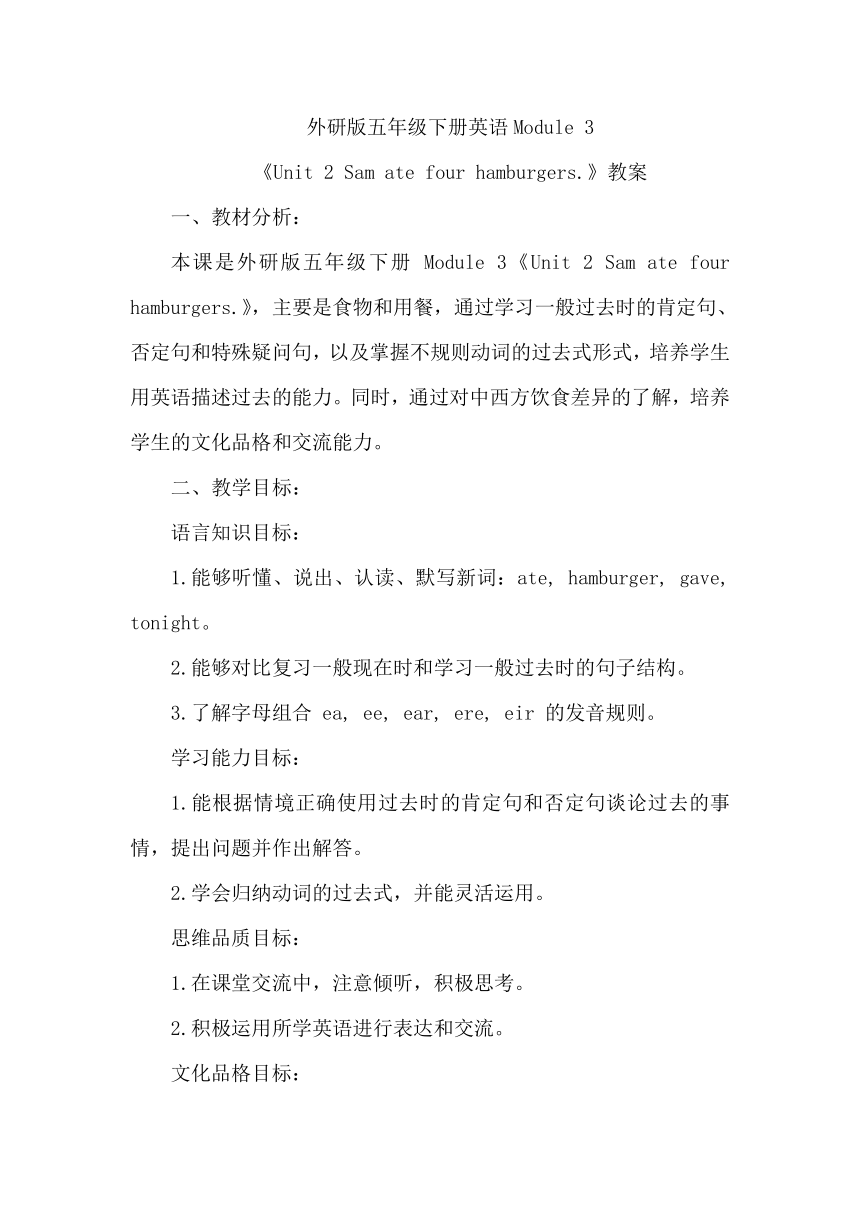 | |
| 格式 | docx | ||
| 文件大小 | 15.8KB | ||
| 资源类型 | 教案 | ||
| 版本资源 | 外研版(三年级起点) | ||
| 科目 | 英语 | ||
| 更新时间 | 2024-03-24 16:48:23 | ||
图片预览

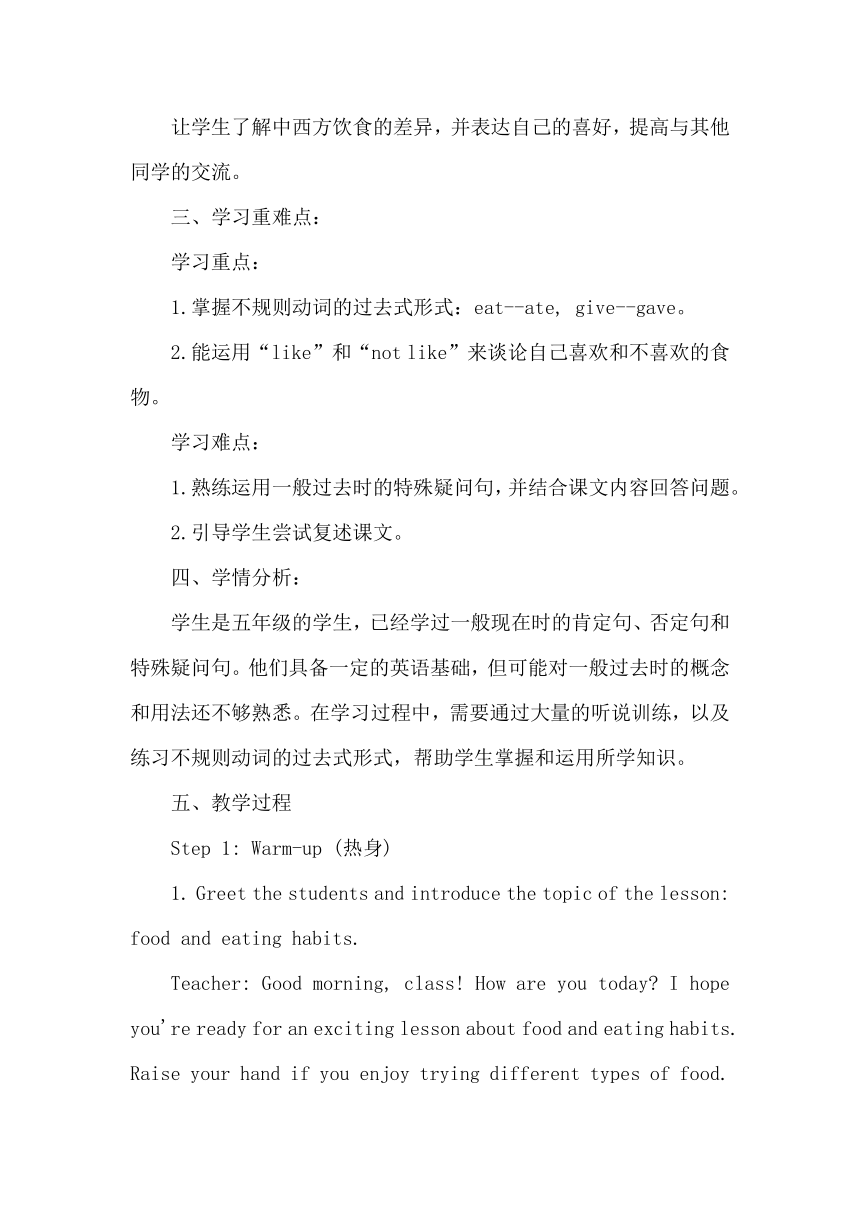
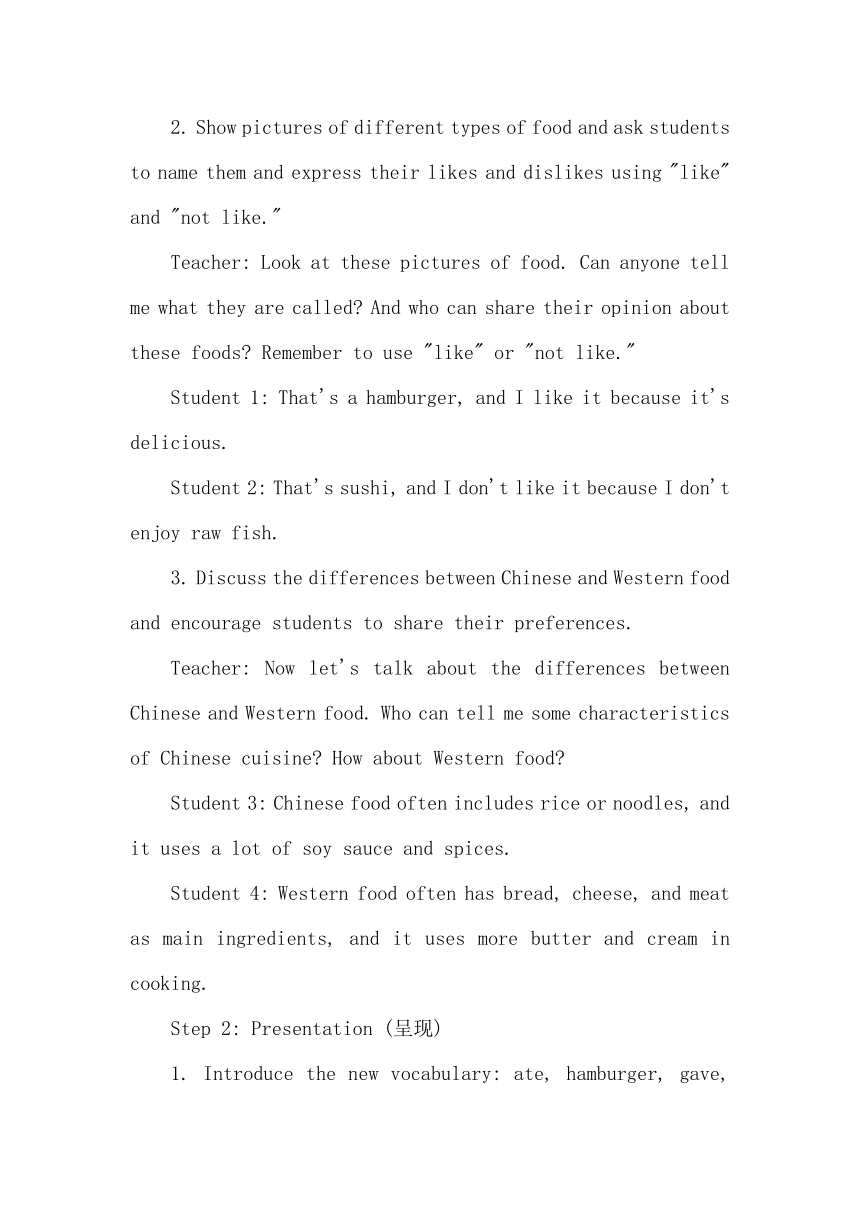
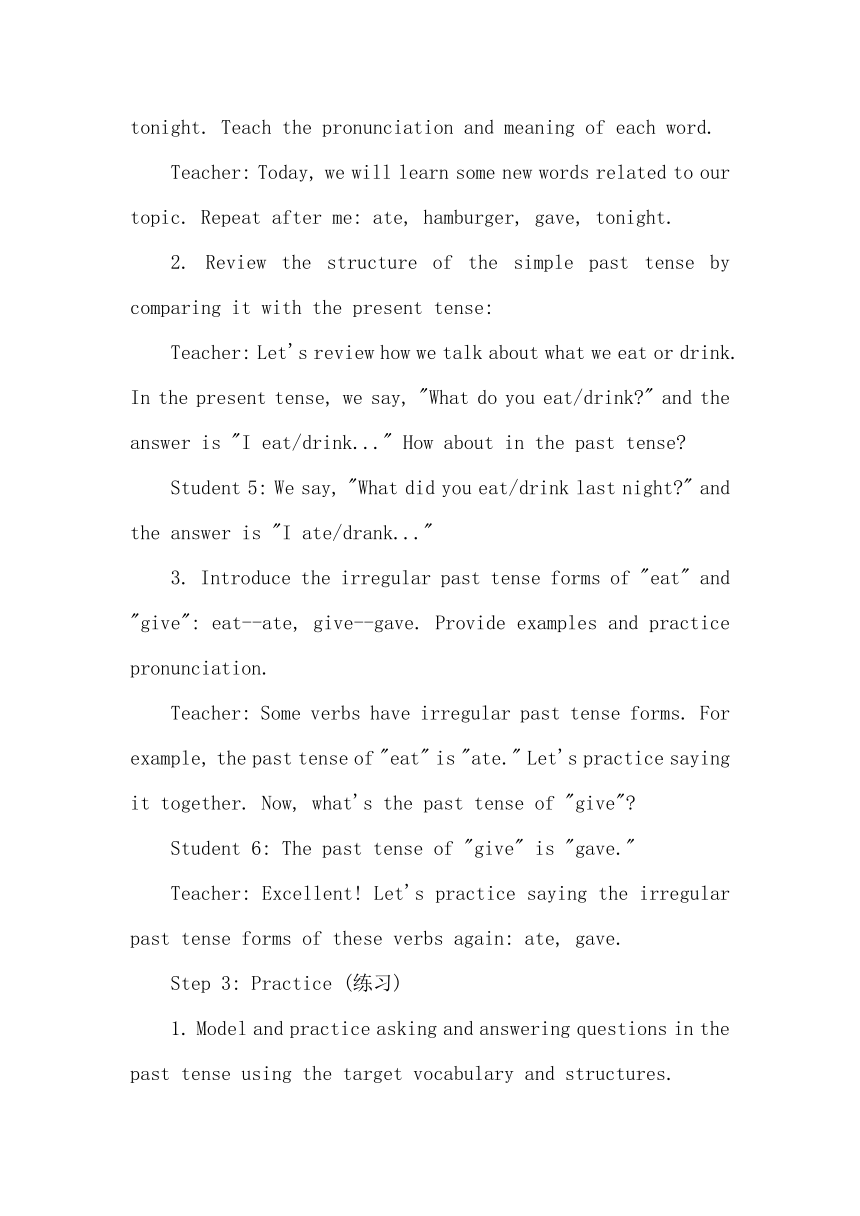
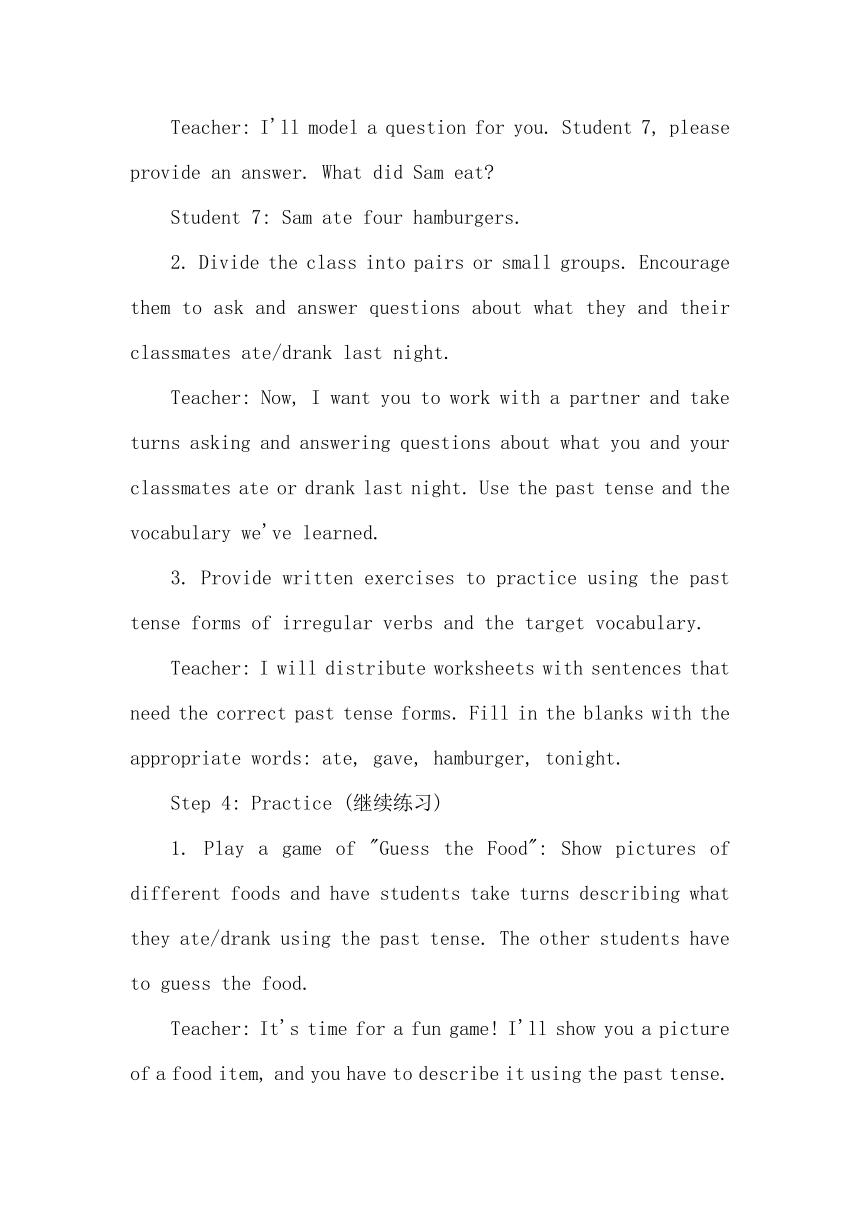
文档简介
外研版五年级下册英语Module 3
《Unit 2 Sam ate four hamburgers.》教案
一、教材分析:
本课是外研版五年级下册 Module 3《Unit 2 Sam ate four hamburgers.》,主要是食物和用餐,通过学习一般过去时的肯定句、否定句和特殊疑问句,以及掌握不规则动词的过去式形式,培养学生用英语描述过去的能力。同时,通过对中西方饮食差异的了解,培养学生的文化品格和交流能力。
二、教学目标:
语言知识目标:
1.能够听懂、说出、认读、默写新词:ate, hamburger, gave, tonight。
2.能够对比复习一般现在时和学习一般过去时的句子结构。
3.了解字母组合 ea, ee, ear, ere, eir 的发音规则。
学习能力目标:
1.能根据情境正确使用过去时的肯定句和否定句谈论过去的事情,提出问题并作出解答。
2.学会归纳动词的过去式,并能灵活运用。
思维品质目标:
1.在课堂交流中,注意倾听,积极思考。
2.积极运用所学英语进行表达和交流。
文化品格目标:
让学生了解中西方饮食的差异,并表达自己的喜好,提高与其他同学的交流。
三、学习重难点:
学习重点:
1.掌握不规则动词的过去式形式:eat--ate, give--gave。
2.能运用“like”和“not like”来谈论自己喜欢和不喜欢的食物。
学习难点:
1.熟练运用一般过去时的特殊疑问句,并结合课文内容回答问题。
2.引导学生尝试复述课文。
四、学情分析:
学生是五年级的学生,已经学过一般现在时的肯定句、否定句和特殊疑问句。他们具备一定的英语基础,但可能对一般过去时的概念和用法还不够熟悉。在学习过程中,需要通过大量的听说训练,以及练习不规则动词的过去式形式,帮助学生掌握和运用所学知识。
五、教学过程
Step 1: Warm-up (热身)
1. Greet the students and introduce the topic of the lesson: food and eating habits.
Teacher: Good morning, class! How are you today I hope you're ready for an exciting lesson about food and eating habits. Raise your hand if you enjoy trying different types of food.
2. Show pictures of different types of food and ask students to name them and express their likes and dislikes using "like" and "not like."
Teacher: Look at these pictures of food. Can anyone tell me what they are called And who can share their opinion about these foods Remember to use "like" or "not like."
Student 1: That's a hamburger, and I like it because it's delicious.
Student 2: That's sushi, and I don't like it because I don't enjoy raw fish.
3. Discuss the differences between Chinese and Western food and encourage students to share their preferences.
Teacher: Now let's talk about the differences between Chinese and Western food. Who can tell me some characteristics of Chinese cuisine How about Western food
Student 3: Chinese food often includes rice or noodles, and it uses a lot of soy sauce and spices.
Student 4: Western food often has bread, cheese, and meat as main ingredients, and it uses more butter and cream in cooking.
Step 2: Presentation (呈现)
1. Introduce the new vocabulary: ate, hamburger, gave, tonight. Teach the pronunciation and meaning of each word.
Teacher: Today, we will learn some new words related to our topic. Repeat after me: ate, hamburger, gave, tonight.
2. Review the structure of the simple past tense by comparing it with the present tense:
Teacher: Let's review how we talk about what we eat or drink. In the present tense, we say, "What do you eat/drink " and the answer is "I eat/drink..." How about in the past tense
Student 5: We say, "What did you eat/drink last night " and the answer is "I ate/drank..."
3. Introduce the irregular past tense forms of "eat" and "give": eat--ate, give--gave. Provide examples and practice pronunciation.
Teacher: Some verbs have irregular past tense forms. For example, the past tense of "eat" is "ate." Let's practice saying it together. Now, what's the past tense of "give"
Student 6: The past tense of "give" is "gave."
Teacher: Excellent! Let's practice saying the irregular past tense forms of these verbs again: ate, gave.
Step 3: Practice (练习)
1. Model and practice asking and answering questions in the past tense using the target vocabulary and structures.
Teacher: I'll model a question for you. Student 7, please provide an answer. What did Sam eat
Student 7: Sam ate four hamburgers.
2. Divide the class into pairs or small groups. Encourage them to ask and answer questions about what they and their classmates ate/drank last night.
Teacher: Now, I want you to work with a partner and take turns asking and answering questions about what you and your classmates ate or drank last night. Use the past tense and the vocabulary we've learned.
3. Provide written exercises to practice using the past tense forms of irregular verbs and the target vocabulary.
Teacher: I will distribute worksheets with sentences that need the correct past tense forms. Fill in the blanks with the appropriate words: ate, gave, hamburger, tonight.
Step 4: Practice (继续练习)
1. Play a game of "Guess the Food": Show pictures of different foods and have students take turns describing what they ate/drank using the past tense. The other students have to guess the food.
Teacher: It's time for a fun game! I'll show you a picture of a food item, and you have to describe it using the past tense. Your classmates will try to guess the food. Let's start!
2. Give each student a small piece of paper and ask them to write three sentences about what they ate/drank last night using the past tense. Collect the papers and read some sentences aloud for the class to guess who wrote them.
Teacher: Now, write three sentences about your dinner last night using the past tense. Keep it a secret! I'll read some sentences, and you have to guess who wrote them.
Step 5: Listening and Speaking (听力和口语)
1. Play an audio recording or read aloud a short dialogue about what Sam ate last night. Ask comprehension questions to check understanding.
Teacher: Listen to this dialogue between Sam and his friend. Afterward, I'll ask you some questions tocheck your understanding. Close your eyes and listen carefully.
2. Have students work in pairs. One student will be Sam, and the other will ask questions about what Sam ate last night. Encourage students to use the target vocabulary and structures in their conversation.
Teacher: Pair up with a classmate. Decide who will be Sam first. Ask your partner questions about what Sam ate last night, and practice using the past tense and the target vocabulary. Then switch roles.
Step 6: Reading and Writing (阅读和写作)
1. Have students read a short passage about Sam's dinner last night. Ask them to underline the past tense verbs and identify the irregular past tense forms.
Teacher: Now, read this passage silently and underline all the past tense verbs you can find. Pay attention to the irregular past tense forms we discussed earlier.
2. In pairs, ask students to take turns retelling the story using their own words. Encourage them to include details about the food and drinks.
Teacher: Work with your partner and take turns retelling the story in your own words. Be sure to include information about what Sam ate and drank last night.
3. Guide students to write a short paragraph about their own dinner last night using the past tense and the target vocabulary.
Teacher: Now, write a paragraph about your dinner last night. Use the past tense and the vocabulary we've learned. Describe the food and drinks you had.
Step 7: Consolidation and Extension (巩固和拓展)
1. Review the pronunciation of the letter combinations: ea, ee, ear, ere, eir. Provide examples of words with these combinations and have students practice reading them aloud.
Teacher: Let's review some letter combinations that can have different pronunciations. Repeat after me: ea (as in "eat"), ee (as in "cheese"), ear (as in "pear"), ere (as in "there"), eir (as in "weird"). Now, let's practice reading some words with these combinations.
2. Ask students to create a menu for a restaurant, including different types of food and drinks. They can use the past tense to describe what people ate/drank at the restaurant.
Teacher: It's time to get creative! Imagine you're designing a menu for a restaurant. Include various types of food and drinks. Use the past tense to describe what people ate or drank at the restaurant.
3. Encourage students to share their menus and discuss their preferences with their classmates. They can use expressions such as "I like..." or "I don't like..." to express their opinions.
Teacher: Now, share your menus with your classmates. Talk about the different food and drinks on your menus and express your preferences. Use expressions like "I like..." or "I don't like..." to explain your choices.
Step 8: Wrap-up (总结)
1. Review the key points of the lesson, including the target vocabulary, the past tense forms of irregular verbs, and the use of "like" and "not like."
Teacher: Let's summarize what we've learned today. Can someone remind us of the new vocabulary words we learned How about the irregular past tense forms And how do we express our preferences
2. Ask students to reflect on what they have learned and how they can use the past tense to talk about past events and experiences.
Teacher: Take a moment to think about what we've covered in today's lesson. How can you use the past tense to talk about what happened in the past Share your thoughts with a partner.
六、板书设计:
Unit 2 Sam ate four hamburgers.
Vocabulary: ate, hamburger, gave, tonight
Structures: What did you eat/drink last night I ate/drank...
Irregular past tense verbs: eat--ate, give--gave
Expressions: I like... / I don't like...
七、教学反思:
本节课通过多种形式的练习和活动,帮助学生掌握了一般过去时的肯定句、否定句和特殊疑问句的用法。学生通过听、说、读、写的综合训练,不仅巩固了新词汇和句型的运用,还提高了他们的听说能力和交流能力。在教学过程中,教师注重了学生的积极参与和思维品质的培养,鼓励他们自主思考和表达,使学习更具有趣味性和实用性。通过反复练习和巩固,学生对一般过去时的掌握程度有了明显提高,同时也了解了中西方饮食的差异,提升了他们的文化品格。
《Unit 2 Sam ate four hamburgers.》教案
一、教材分析:
本课是外研版五年级下册 Module 3《Unit 2 Sam ate four hamburgers.》,主要是食物和用餐,通过学习一般过去时的肯定句、否定句和特殊疑问句,以及掌握不规则动词的过去式形式,培养学生用英语描述过去的能力。同时,通过对中西方饮食差异的了解,培养学生的文化品格和交流能力。
二、教学目标:
语言知识目标:
1.能够听懂、说出、认读、默写新词:ate, hamburger, gave, tonight。
2.能够对比复习一般现在时和学习一般过去时的句子结构。
3.了解字母组合 ea, ee, ear, ere, eir 的发音规则。
学习能力目标:
1.能根据情境正确使用过去时的肯定句和否定句谈论过去的事情,提出问题并作出解答。
2.学会归纳动词的过去式,并能灵活运用。
思维品质目标:
1.在课堂交流中,注意倾听,积极思考。
2.积极运用所学英语进行表达和交流。
文化品格目标:
让学生了解中西方饮食的差异,并表达自己的喜好,提高与其他同学的交流。
三、学习重难点:
学习重点:
1.掌握不规则动词的过去式形式:eat--ate, give--gave。
2.能运用“like”和“not like”来谈论自己喜欢和不喜欢的食物。
学习难点:
1.熟练运用一般过去时的特殊疑问句,并结合课文内容回答问题。
2.引导学生尝试复述课文。
四、学情分析:
学生是五年级的学生,已经学过一般现在时的肯定句、否定句和特殊疑问句。他们具备一定的英语基础,但可能对一般过去时的概念和用法还不够熟悉。在学习过程中,需要通过大量的听说训练,以及练习不规则动词的过去式形式,帮助学生掌握和运用所学知识。
五、教学过程
Step 1: Warm-up (热身)
1. Greet the students and introduce the topic of the lesson: food and eating habits.
Teacher: Good morning, class! How are you today I hope you're ready for an exciting lesson about food and eating habits. Raise your hand if you enjoy trying different types of food.
2. Show pictures of different types of food and ask students to name them and express their likes and dislikes using "like" and "not like."
Teacher: Look at these pictures of food. Can anyone tell me what they are called And who can share their opinion about these foods Remember to use "like" or "not like."
Student 1: That's a hamburger, and I like it because it's delicious.
Student 2: That's sushi, and I don't like it because I don't enjoy raw fish.
3. Discuss the differences between Chinese and Western food and encourage students to share their preferences.
Teacher: Now let's talk about the differences between Chinese and Western food. Who can tell me some characteristics of Chinese cuisine How about Western food
Student 3: Chinese food often includes rice or noodles, and it uses a lot of soy sauce and spices.
Student 4: Western food often has bread, cheese, and meat as main ingredients, and it uses more butter and cream in cooking.
Step 2: Presentation (呈现)
1. Introduce the new vocabulary: ate, hamburger, gave, tonight. Teach the pronunciation and meaning of each word.
Teacher: Today, we will learn some new words related to our topic. Repeat after me: ate, hamburger, gave, tonight.
2. Review the structure of the simple past tense by comparing it with the present tense:
Teacher: Let's review how we talk about what we eat or drink. In the present tense, we say, "What do you eat/drink " and the answer is "I eat/drink..." How about in the past tense
Student 5: We say, "What did you eat/drink last night " and the answer is "I ate/drank..."
3. Introduce the irregular past tense forms of "eat" and "give": eat--ate, give--gave. Provide examples and practice pronunciation.
Teacher: Some verbs have irregular past tense forms. For example, the past tense of "eat" is "ate." Let's practice saying it together. Now, what's the past tense of "give"
Student 6: The past tense of "give" is "gave."
Teacher: Excellent! Let's practice saying the irregular past tense forms of these verbs again: ate, gave.
Step 3: Practice (练习)
1. Model and practice asking and answering questions in the past tense using the target vocabulary and structures.
Teacher: I'll model a question for you. Student 7, please provide an answer. What did Sam eat
Student 7: Sam ate four hamburgers.
2. Divide the class into pairs or small groups. Encourage them to ask and answer questions about what they and their classmates ate/drank last night.
Teacher: Now, I want you to work with a partner and take turns asking and answering questions about what you and your classmates ate or drank last night. Use the past tense and the vocabulary we've learned.
3. Provide written exercises to practice using the past tense forms of irregular verbs and the target vocabulary.
Teacher: I will distribute worksheets with sentences that need the correct past tense forms. Fill in the blanks with the appropriate words: ate, gave, hamburger, tonight.
Step 4: Practice (继续练习)
1. Play a game of "Guess the Food": Show pictures of different foods and have students take turns describing what they ate/drank using the past tense. The other students have to guess the food.
Teacher: It's time for a fun game! I'll show you a picture of a food item, and you have to describe it using the past tense. Your classmates will try to guess the food. Let's start!
2. Give each student a small piece of paper and ask them to write three sentences about what they ate/drank last night using the past tense. Collect the papers and read some sentences aloud for the class to guess who wrote them.
Teacher: Now, write three sentences about your dinner last night using the past tense. Keep it a secret! I'll read some sentences, and you have to guess who wrote them.
Step 5: Listening and Speaking (听力和口语)
1. Play an audio recording or read aloud a short dialogue about what Sam ate last night. Ask comprehension questions to check understanding.
Teacher: Listen to this dialogue between Sam and his friend. Afterward, I'll ask you some questions tocheck your understanding. Close your eyes and listen carefully.
2. Have students work in pairs. One student will be Sam, and the other will ask questions about what Sam ate last night. Encourage students to use the target vocabulary and structures in their conversation.
Teacher: Pair up with a classmate. Decide who will be Sam first. Ask your partner questions about what Sam ate last night, and practice using the past tense and the target vocabulary. Then switch roles.
Step 6: Reading and Writing (阅读和写作)
1. Have students read a short passage about Sam's dinner last night. Ask them to underline the past tense verbs and identify the irregular past tense forms.
Teacher: Now, read this passage silently and underline all the past tense verbs you can find. Pay attention to the irregular past tense forms we discussed earlier.
2. In pairs, ask students to take turns retelling the story using their own words. Encourage them to include details about the food and drinks.
Teacher: Work with your partner and take turns retelling the story in your own words. Be sure to include information about what Sam ate and drank last night.
3. Guide students to write a short paragraph about their own dinner last night using the past tense and the target vocabulary.
Teacher: Now, write a paragraph about your dinner last night. Use the past tense and the vocabulary we've learned. Describe the food and drinks you had.
Step 7: Consolidation and Extension (巩固和拓展)
1. Review the pronunciation of the letter combinations: ea, ee, ear, ere, eir. Provide examples of words with these combinations and have students practice reading them aloud.
Teacher: Let's review some letter combinations that can have different pronunciations. Repeat after me: ea (as in "eat"), ee (as in "cheese"), ear (as in "pear"), ere (as in "there"), eir (as in "weird"). Now, let's practice reading some words with these combinations.
2. Ask students to create a menu for a restaurant, including different types of food and drinks. They can use the past tense to describe what people ate/drank at the restaurant.
Teacher: It's time to get creative! Imagine you're designing a menu for a restaurant. Include various types of food and drinks. Use the past tense to describe what people ate or drank at the restaurant.
3. Encourage students to share their menus and discuss their preferences with their classmates. They can use expressions such as "I like..." or "I don't like..." to express their opinions.
Teacher: Now, share your menus with your classmates. Talk about the different food and drinks on your menus and express your preferences. Use expressions like "I like..." or "I don't like..." to explain your choices.
Step 8: Wrap-up (总结)
1. Review the key points of the lesson, including the target vocabulary, the past tense forms of irregular verbs, and the use of "like" and "not like."
Teacher: Let's summarize what we've learned today. Can someone remind us of the new vocabulary words we learned How about the irregular past tense forms And how do we express our preferences
2. Ask students to reflect on what they have learned and how they can use the past tense to talk about past events and experiences.
Teacher: Take a moment to think about what we've covered in today's lesson. How can you use the past tense to talk about what happened in the past Share your thoughts with a partner.
六、板书设计:
Unit 2 Sam ate four hamburgers.
Vocabulary: ate, hamburger, gave, tonight
Structures: What did you eat/drink last night I ate/drank...
Irregular past tense verbs: eat--ate, give--gave
Expressions: I like... / I don't like...
七、教学反思:
本节课通过多种形式的练习和活动,帮助学生掌握了一般过去时的肯定句、否定句和特殊疑问句的用法。学生通过听、说、读、写的综合训练,不仅巩固了新词汇和句型的运用,还提高了他们的听说能力和交流能力。在教学过程中,教师注重了学生的积极参与和思维品质的培养,鼓励他们自主思考和表达,使学习更具有趣味性和实用性。通过反复练习和巩固,学生对一般过去时的掌握程度有了明显提高,同时也了解了中西方饮食的差异,提升了他们的文化品格。
同课章节目录
- Module 1
- Unit 1 We lived in a small house.
- Unit 2 She didn't have a television.
- Module 2
- Unit 1 She learnt English.
- Unit 2 Mr Li was a teacher.
- Module 3
- Unit 1 She had eggs and sausages.
- Unit 2 Sam ate four hamburgers.
- Module 4
- Unit 1 Let's make a home library.
- Unit 2 We can find information from books and CDs.
- Module 5
- Unit 1 It's big and light.
- Unit 2 It's too big for you.
- Module 6
- Unit 1 I went there last year.
- Unit 2 She visited the Tianchi Lake.
- Module 7
- Unit 1 My father goes to work at eight o'clock eve
- Unit 2 I'll be home at seven o'clock.
- Module 8
- Unit 1 Will you help me?
- Unit 2 I made a kite.
- Module 9
- Unit 1 We laughed a lot.
- Unit 2 Mum bought new T-shirts for you.
- Module 10
- Unit 1 Where are you going to go?
- Unit 2 I'm in New York now.
- Review Module
- Unit 1
- Unit 2
